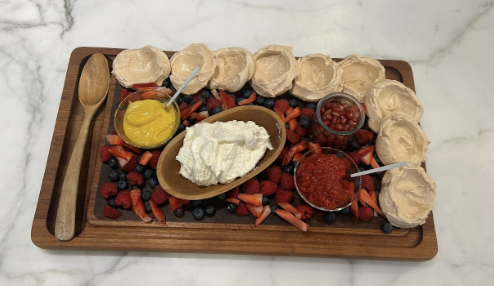Your computer science class is gathered outside the classroom before class. Everyone gradually forms circles, chatting about the latest assignment, the upcoming test and the overall school day. You are in one of these circles too—but you feel nearly invisible, as if the conversations are happening above you. That’s because you are one of only a handful of girls in your upper-level STEM class, and, regardless of how much you engage in class or how hard you study, you always feel like the odd one out.
According to MIT, women made up only 28% of the STEM workforce in 2023. This disparity is also expressed in the low number of girls enrolled in STEM classes in college and high school: upper-level physics courses at Staples range from 62% to 81% male, while computer science classes range from 71% to 84% male. These statistics about Staples classes, along with all others referenced, are from the Staples guidance office. The gender divide in Staples STEM classes can create an uncomfortable learning environment for girls, hindering their ability to succeed in the classroom.
“I feel less open to speak and share my answers, because it’s very dominated by males,” Amanda, (fake name given to protect anonymity) a Staples girl taking AP Physics 1 said. “The people who dominate are very loud and take up a lot of space in the classroom.”
A common theme involves female students feeling uncomfortable speaking up, asking questions or sharing their thought processes in certain STEM classes, while their male counterparts do not experience that same stigma. In the 2024-25 school year, the ratio of male to female students enrolled in AP Physics 1 is 74% to 26%.
“The privilege that the males generally have in these classes is that they feel so free to speak their minds, and I feel like girls just don’t have that privilege,” Amanda said. “Instead of just feeling open to speak or share my opinions, I feel like I have to disclaim by saying ‘oh I’m not sure.’ I feel like I’ll be judged more by my male peers if mistakes are made or if my opinions or ideas aren’t a thousand percent correct.”
Other students corroborated this experience.
“I do think when [a question] pops into their [boys’] head, they’re immediately [willing to ask]. Whereas I’m always like, ‘oh, okay, let me try my best not to ask a question,’” Carolina Proctor ’25 said. “You’re almost trapped in your own head, so it’s hard to actively go seek that outside help.”
Proctor, one of four girls in her 17-person AP Physics C class, describes that despite the boys in her class being generally respectful, the classroom environment can still be difficult to navigate.
“It’s not easy to be in a physics class with almost all boys because I don’t feel comfortable a lot of the time,” Proctor said. “In other classes—like bio, chem—I’ve always been very willing to share and participate. But when there are so many guys, it does get more difficult, just because you feel like you’re more singled out and like you’re being judged more.”
A study by the American Society for Cell Biology found that females participated more in classes with more females in attendance, which correlated to higher final grades. However, this phenomenon often goes unnoticed by male students and educators.
To add to the issue, AP Physics C has even fewer girls than AP Physics 1, with an 81% male to 19% female ratio. Notably, while AP Physics 1 is considered an introductory class, AP Physics C has a Physics Honors prerequisite. While Physics Honors is already skewed male, (62% to 38%), there is a significant dropoff of female students who take the next step to AP Physics C.
“I don’t know [why many girls don’t go on to Physics C]. I can say that, for a long time, Physics Honors was taught by male teachers. I don’t think they did an active job to discourage them [girls], but I don’t know if they did as much to encourage them,” Physics teacher Joanne Klouda said. “When I taught Physics Honors, I was constantly saying ‘If you like this, take AP Physics, you’re going to be great.’”
Students also agree that the role teachers play in cultivating the classroom environment is vital to the comfort levels of girls taking male-dominated classes. In some cases, having a female teacher can help.
“Last year I took a different science course and I had a female teacher, and she was very inclusive of everyone. When people were speaking out she’d tell them to stop speaking out and to give other people a chance to speak, which encouraged a more open environment for everyone,” Amanda said.
Teachers are not directly responsible for the problem, however, and no students have blamed their discomfort on having a male STEM teacher. Often, despite teachers’ best efforts to be kind, open, and receptive to questions, girls feel intimidated due to factors outside the teacher’s control.
“I never really felt like, when I was asking questions, I was put down because I’m a girl asking questions. I think [it’s] because my teacher is great and loves people asking questions,” Stella St. Andre ’25 said. “[But] for some people it can be intimidating being one of the few girls in class, which makes them not want to ask as many questions.”
St. Andre has taken computer science all four of her years of high school. At Staples, Introduction to Programming is a prerequisite for all upper-level computer science classes; it is the gateway to the APs and other advanced classes such as Applied Algorithmic Design. Mainly taken by underclassmen, Intro to Programming is 71% male, 28% female.
St. Andre is also co-president of Girls Who Code, a club that is particularly valuable to underclassmen taking computer science classes, as a place for them to get help with homework, or ask questions they might be nervous to broach in class. It is also a resource for girls in computer science to connect with other girls interested in the same field.
“I was like, ‘oh, I didn’t know this person coded,’ or ‘oh, I wouldn’t expect her to be in this club,” Elena Nasar ’27 said. “[There is] the stereotype that ‘girly’ girls don’t like [coding], they like English. I don’t agree with that stereotype, but that is something I thought at first. [Through Girls Who Code] I saw there’s a lot of different kinds of people who are interested in it.”
Stereotypes and assumptions can be a large barrier for women pursuing STEM fields. According to MIT, many individuals still associate STEM fields with masculine qualities. This leads to stereotypes that discourage women from pursuing STEM.
“I do think you’re expected to take a path [humanities or STEM],” Proctor said. “And since most girls pick that humanities path—for whatever reason, I don’t know if that’s actually what they want, or if that’s what they feel like they should do—[others] feel like they should also take that path.”
Another factor that can’t be ignored is a snowball effect: girls feel hesitant to take STEM classes such as computer science because they are concerned about the overwhelming percentage of male students, which leads to a cycle of fewer girls enrolling in those classes.
“I think [the gender divide] probably scares some girls out of doing it because there is this stigma that girls don’t do comp sci or because it’s like a ‘guy thing,’” St. Andre said. “That has reflected in there being more guys in the classroom, and it’s just a cycle.”
After taking Intro to Programming, students can take upper-level computer science classes, including AP Computer Science Principles and AP Computer Science A. Both of the APs have fewer girls than Intro; AP CSP has a ratio of 79% to 21%, while AP CSA is 84% to 16%. Although both classes have the same prerequisites, AP CSA is colloquially considered to be the “more difficult” class; a popular progression of computer science classes for the average student starts with Intro, then CSP, and then CSA. With each step higher on the computer science ladder, the ratio of male to female students becomes more unequal.
The important takeaway? Intro to Programming starts out already skewed male, but far more girls than boys drop the computer science track between Intro and APs. This pattern is similar to the dropoff of female students between Physics Honors and AP Physics C.
Leah Dombrow ’27, an AP CSA student, describes that while she now enjoys computer science, she was initially apprehensive.
“Being in the class has been a good experience for me even though I was hesitant about joining it at first,” Dombrow said. “I wasn’t expecting to take computer science classes, because I didn’t have a lot of friends or other people I knew in my grade who were going into this class.”
Seeing a lack of female friends or peers taking computer science can often be a deterrent for girls. This year, Dombrow is the one and only girl in her AP Computer Science A class.
“[Being the only girl in class] was definitely a little bit uncomfortable at first, because I didn’t expect it. I didn’t know the teacher or the students well, so it was a little hard to ask for help sometimes,” Dombrow said. “But I think I’ve definitely gotten used to it. I don’t talk much in the class, but I do enjoy it.”
So, what’s the solution to the gender gap in STEM enrollment? How can administrators prevent another girl from being the only one in her 19-person AP Computer Science class? There is no easy answer, but the first step is showing strong support towards girls considering STEM paths.
“Even though we’re trying to get more women to be in STEM, that change doesn’t come right away. Guys just go into it having more confidence,” Proctor said. “I think there would have to be really active encouragement towards girls who are potentially going into a class like that [STEM], and just letting them know ‘hey, you can do this.’”
Ellie Ferraro ’27, a current computer science student, credits her start in the subject area to her eighth grade engineering teacher, and implores more teachers on the middle school level to encourage their female students.
“My engineering teacher at the time was like ‘you should go into this.’ When I did Intro to Programming I loved it, it was my favorite class the whole year,” Ferraro said. “[Teachers should] get more recommendations out to girls; just tell them to take it and tell them about the advantages. I wouldn’t have even taken these classes in the first place [without my teacher’s recommendation] and they ended up being my favorite classes I’ve ever taken.”
Since Intro to Programming—the prerequisite for all other computer science classes—is mainly taken by underclassmen, it is important for middle school and freshman teachers to show encouragement and support towards their female students considering those paths. Sometimes, even just going out of the way to suggest a girl take programming can be enough. The principle applies to the Physics track.
“I worked really hard in Physics Honors to encourage the women in the class to take AP Physics,” Klouda said. “The next year I didn’t teach AP Physics, but I think a lot of those women did go. I think it’s important to encourage girls in the prior science classes.”
A second step is to expand the community for girls taking STEM classes once they get to high school, ensuring that girls on a STEM track don’t drop off that track due to external factors. A “Girls in Physics” or “Girls in STEM” club would be a good complement to the already-existing Girls Who Code club.
“Girls Who Code is valuable because it takes girls that might feel like they’re the minority in their computer science classes, but shows them there’s so many girls out there who are also coding,” St. Andre said. “It’s a space where you don’t feel so small in this big male-dominated field.”














































